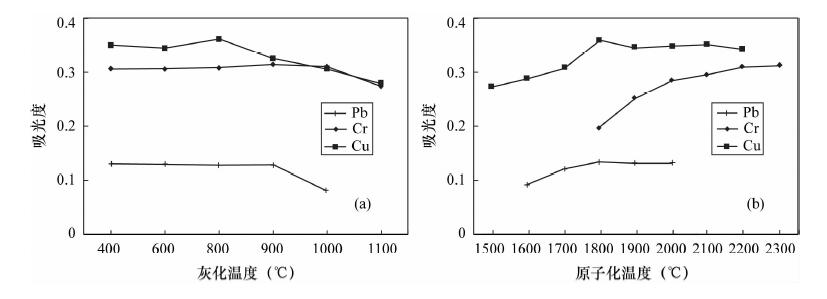Determination of Trace Lead, Chromium and Copper in Volcanic Ash from Shinmoe-Dake Volcano by Microwave Digestion-Graphite Furnace Atomic Absorption Spectrometry
-
摘要: 火山灰是重要的土壤母质且易风化, 铅、铬和铜是其中主要的重金属元素, 样品风化后不可避免地进入环境中对人体健康造成危害。本研究针对火山灰样品的特点, 建立了采用硝酸-氢氟酸微波消解, 石墨炉原子吸收光谱法测定火山灰中痕量铅、铬、铜的分析方法。通过实验确定了灰化温度为600℃(Pb)、1000℃(Cr)和800℃(Cu), 原子化温度为1800℃(Pb和Cu)、2200℃(Cr)。在优化实验条件下, 测定Pb、Cr和Cu的检出限分别为3.50 ng/mL、0.92 ng/mL和1.22 ng/mL, 相对标准偏差(RSD)均低于4%, 加标回收率为92.8%~107.0%。本方法快速简便、准确度高、成本低。
-
关键词:
- 火山灰 /
- 重金属 /
- 硝酸-氢氟酸 /
- 微波消解 /
- 石墨炉原子吸收光谱法
Abstract: Volcanic ash is an important parent material for soil and is easily weathered. Pb, Cr and Cu are the main heavy metals in weathered volcanic ash and are inevitably discharged into the environment and finally harmful to human health. A simple and reliable method for the determination of Pb, Cr and Cu in volcanic ash by microwave digestion combined with Graphite Furnace Atomic Absorption Spectrometry (GFAAS) has been proposed. The ashing temperatures are 600℃ for Pb, 1000℃ for Cr and 800℃ for Cu. The atomization temperatures are 1800℃ for Pb and Cu, and 2200℃ for Cr. The detection limits of the proposed method are 3.50, 0.92 and 1.22 ng/mL for Pb, Cr and Cu, respectively. The relative standard deviations (RSDs) for eleven replicate analyses (50 ng/mL) of the above three metals are less than 4%, and the recoveries by standard addition are 92.8%-107.0%. The proposed method is rapid and convenient with high accuracy and low cost. -
火山灰是爆发式火山的熔浆喷发到空中冷凝后坠落地表所形成的细小碎屑物质[1]。火山灰结晶度低、颗粒小、易风化[2]。铅、铬和铜是火山灰中存在的主要重金属元素,其中铅和铬是有毒元素,易沉积在生命组织中,对人体多个器官和组织造成损伤[3];铜是人体所必需的微量元素,但是超过一定的浓度范围就会产生危害[4]。更为重要的是,火山灰经风化后,其中的重金属元素会通过环境进入生物圈,直接或间接地对人体造成危害。因此,从公共健康和环境的角度考虑,准确测定火山灰中的重金属元素含量具有现实意义。
火山灰样品中重金属元素的测试多采用不同的辐射条件进行对其进行中子活化分析[5, 6],另外已有采用电感耦合等离子体质谱(ICP-MS)[6]等方法。NAA需要有昂贵的核反应堆或者离子加速器且分析周期较长,ICP-MS是目前公认的测定痕量元素的最有效手段之一。相比于前两种分析方法,石墨炉原子吸收光谱法(GFAAS)具有仪器价格低、特效性好、适用性广、操作简便等特点,在金属元素分析中显示了特有的优势,已被广泛应用于多种样品中重金属元素的检测[7, 8, 9, 10]。鉴于此,发展一种成本低廉、具有推广价值的测定方法用于火山灰样品中痕量重金属元素的分析以科学评价其环境危害具有实际意义。
2011年3月,日本雾岛山中的新燃岳火山喷发,喷出的火山灰超过7000万吨,烟尘高达3000米,使当地农业遭受重大损失。本研究采集了新燃岳火山的火山灰样品,建立了采用硝酸-氢氟酸微波消解[11, 12, 13, 14],GFAAS准确、快速地测定火山灰中痕量铅、铬和铜的分析方法。
1. 实验部分
1.1 仪器与工作条件
TAS-990原子吸收分光光度计(北京普析通用仪器有限责任公司),配置横向加热石墨管,带氘灯背景校正器。空心阴极灯(北京曙光明电子光源仪器有限公司)。GFAAS仪器工作条件和石墨炉升温程序见表 1所示。
表 1 GFAAS仪器工作条件和石墨炉升温程序Table 1. Operating parameters of the GFAAS instrument and temperature programs of graphite furnace
待测
元素GFAAS仪器工作条件 石墨炉升温程序 分析波长
(nm)灯电流
(mA)光谱带宽
(nm)背景校正 干燥条件 灰化条件 原子化条件 净化条件 Pb 283.3 2.0 0.4 氘灯校正 100℃, 10/15s 600℃, 10/15s 1800℃, 0/3s 2100℃, 0/2s Cr 357.9 4.0 0.4 氘灯校正 100℃, 10/15s 1000℃, 10/15s 2200℃, 0/4s 2400℃, 0/2s Cu 324.8 3.0 0.4 氘灯校正 100℃, 10/15s 800℃, 10/15s 1800℃, 0/4s 2100℃, 0/2s BS-210S电子天平(北京赛多利斯仪器系统有限公司)。
MK-Ⅲ型微波消解仪(上海新科微波溶样测试技术研究所)。
1.2 标准溶液和主要试剂
标准储备液(1000 mg/L):购自国家钢铁材料测试中心钢铁研究总院。使用前将标准储备液用5%的硝酸逐级稀释成标准溶液系列。
所有试剂均为分析纯或优级纯。
待用的容器都是在10%的硝酸中浸泡24 h,超纯水用于全部实验。
1.3 样品制备和分析测定
准确称取于100℃烘干至恒重的200目样品0.1000 g,置于聚四氟乙烯微波消解罐中,加少许超纯水润湿,向样品中缓慢滴加2.0 mL氢氟酸和4.0 mL硝酸,摇匀后加盖旋紧,放入微波消解仪中。调压力1.0 MPa,加热75 min。待反应罐冷却后打开,消解后的溶液无色澄清,用5%的硝酸定容至50 mL,摇匀待测。采用相同的程序处理试剂空白,所得实验数据均扣除了相应的空白值。
在最佳的工作条件下,采用数字式移液器吸取10 μL标准溶液或已处理好的样品消解液于石墨管中,用GFAAS法测定,以峰高记录信号强度,根据工作曲线计算样品中重金属元素的含量。
2. 结果与讨论
2.1 微波消解条件的选择
常用的地质样品制备方法有湿法消解[15, 16]、干法灰化[17]和微波消解法[11, 12, 14]。其中,湿法消解操作繁琐,消耗试剂较多,样品易沾污;干法灰化需加入大量熔剂助熔,故可能引入熔剂本身的离子和其中的杂质。与前两种方法相比,微波消解法因其具有简单快速、试剂及酸消耗量少、样品污染小等特点得到了广泛的关注。针对火山灰样品的特点,本实验选用硝酸-氢氟酸混合酸体系溶解样品。在GFAAS分析中,硝酸由于其强酸性、强氧化性、光谱干扰小等优点,是理想的微波消解试剂;氢氟酸可以有效破坏火山灰中的SiO2晶格,释放晶格中的组分。实验考察了不同比例的硝酸、氢氟酸混合酸的消解效果,结果表明,4 mL硝酸-2 mL氢氟酸可以将0.1000 g火山灰样品消解完全,获得无色澄清的消解液。
微波消解程序中,消解时间和压力是最重要的参数。一般情况下,较长的消解时间和较大的消解压力,样品消解就越完全,但考虑到仪器寿命,均不宜设置过大。本文选择硝酸-氢氟酸作为消解试剂,结果表明消解压力为1.0~2.0 MPa,消解时间在75~90 min范围内时,均能使试样消解完全。本实验选择压力为1.0 MPa,消解时间为75 min。
2.2 石墨炉程序升温条件的优化
(1) 干燥温度:干燥的目的是在低温下蒸发去除溶剂,但不允许待测元素有任何损失。为防止石墨管内样品发生飞溅,本实验采用斜坡升温方式,干燥温度选择100℃,并保持15 s。
(2) 灰化温度:以火山灰消解液为测试溶液,绘制灰化曲线。实验结果(图 1a)显示:Pb、Cr、Cu分别在900℃、1000℃、800℃以上温度出现了灰化损失。由于火山灰中P含量达0.2%[18],消解后P基本全部转变为PO43-,PO43-与Pb2+结合生成热稳定性物质,因此消解液中Pb允许的灰化温度较标准溶液(600℃)[19]高。若采用太高的灰化温度,标准溶液中的Pb将会产生灰化损失而影响测定结果的准确性。综合考虑,本实验选择Pb的灰化温度为600℃,Cr和Cu的灰化温度分别为1000℃和800℃。同时考察了灰化时间的影响(10~30 s),实验结果表明灰化时间过长(>15 s),将导致待测元素分析信号下降,为此本实验选择的灰化时间为15 s。
(3) 原子化温度:原子化温度的影响结果如图 1b所示。各元素随着温度的升高,吸光度增大进而保持不变。考虑到温度太低,待测元素原子化不完全,信号强度较低,导致灵敏度较差,而温度太高则会降低石墨管的使用寿命,本实验最终选择Pb和Cu的原子化温度为1800℃,Cr的原子化温度为2200℃。同时要合理地选择原子化时间,时间过长会影响石墨管寿命,时间过短则会造成待测元素和基体物质在管内残留聚集,因此本实验选择Pb的原子化时间为3 s,Cr和Cu的原子化时间均为4 s。
2.3 干扰试验
火山灰的化学成分主要有氧、硅、铝、铁、钾、钠、钛、钙、镁等10余种元素。实验中固定待测物的浓度均为50 ng/mL,考察了常见共存离子对待测元素的干扰情况,以使待测元素的测定误差小于±10%时的共存离子浓度为最大允许量。对共存离子的最大允许量(mg/mL)为:K+ (2000);Na+ (1000);Ca2+、Mg2+ (500);Al3+ (1500);Fe3+、Ti4+ (300);Mn2+ (200);Ba2+(100);Zn2+ (50)。
2.4 方法检出限和精密度
在优化实验条件下连续测定试剂空白11次,根据IUPAC定义,本法检出限:Pb为3.50 ng/mL,Cr为0.92 ng/mL,Cu为1.22 ng/mL。测定50 ng/mL的Pb、Cr、Cu标准溶液各11次,计算相对标准偏差(RSD)在2.1%(Pb)~3.6%(Cr)之间。各元素的线性方程、线性范围、检出限及精密度见表 2。
表 2 方法的分析性能Table 2. Analytical performance of the method待测
元素线性方程 线性范围
(ng/mL)相关
系数检出限
(ng/mL)RSD
(%)Pb y=0.0025ρ+0.0508 0~200 0.9937 3.50 2.1 Cr y=0.0061ρ+0.0403 0~100 0.9968 0.92 3.6 Cu y=0.0051ρ+0.0026 0~100 0.9991 1.22 2.8 2.5 火山灰样品测定及方法回收率
在优化实验条件下,对火山灰样品进行分析,所得实验结果均扣除相应的空白值。由表 3可见,3种重金属的加标回收率在92.8%~107.0%之间,满足了痕量元素分析的要求。
表 3 火山灰样品待测元素含量及加标回收率Table 3. Analytical results of three heavy metals in volcanic ash samples and spiked recovery of the method待测
元素样品测定值
(μg/g)加标值
(μg/g)加标后测定值
(μg/g)回收率
(%)Pb 8.82±0.44 4 11.9±0.61 92.8 8 17.5±0.95 104.0 Cr 12.0±0.32 6 16.8±0.52 93.3 12 22.9±1.21 95.4 Cu 21.3±0.13 10 33.6±2.43 107.0 20 39.2±2.13 94.9 3. 结论
本文建立了硝酸-氢氟酸微波消解,GFAAS测定火山灰样品中痕量铅铬铜的分析方法。本方法操作简便,精密度和准确度均能满足痕量分析要求,与现在普遍采用的中子活化分析法相比,成本低廉,更具有推广价值。采用的微波消解技术可以极大地提高分析效率,但微波消解设备的样品处理数量有限,对于大批量样品的处理能力还有待进一步提高。
-
表 1 GFAAS仪器工作条件和石墨炉升温程序
Table 1 Operating parameters of the GFAAS instrument and temperature programs of graphite furnace
待测
元素GFAAS仪器工作条件 石墨炉升温程序 分析波长
(nm)灯电流
(mA)光谱带宽
(nm)背景校正 干燥条件 灰化条件 原子化条件 净化条件 Pb 283.3 2.0 0.4 氘灯校正 100℃, 10/15s 600℃, 10/15s 1800℃, 0/3s 2100℃, 0/2s Cr 357.9 4.0 0.4 氘灯校正 100℃, 10/15s 1000℃, 10/15s 2200℃, 0/4s 2400℃, 0/2s Cu 324.8 3.0 0.4 氘灯校正 100℃, 10/15s 800℃, 10/15s 1800℃, 0/4s 2100℃, 0/2s 表 2 方法的分析性能
Table 2 Analytical performance of the method
待测
元素线性方程 线性范围
(ng/mL)相关
系数检出限
(ng/mL)RSD
(%)Pb y=0.0025ρ+0.0508 0~200 0.9937 3.50 2.1 Cr y=0.0061ρ+0.0403 0~100 0.9968 0.92 3.6 Cu y=0.0051ρ+0.0026 0~100 0.9991 1.22 2.8 表 3 火山灰样品待测元素含量及加标回收率
Table 3 Analytical results of three heavy metals in volcanic ash samples and spiked recovery of the method
待测
元素样品测定值
(μg/g)加标值
(μg/g)加标后测定值
(μg/g)回收率
(%)Pb 8.82±0.44 4 11.9±0.61 92.8 8 17.5±0.95 104.0 Cr 12.0±0.32 6 16.8±0.52 93.3 12 22.9±1.21 95.4 Cu 21.3±0.13 10 33.6±2.43 107.0 20 39.2±2.13 94.9 -
-
期刊类型引用(11)
1. 赵亚男,王小强,杜天军,余文丽,杨惠玲. 熔融制样–X-射线荧光光谱法测定伟晶岩中主次量组分. 化学分析计量. 2021(04): 20-24 .  百度学术
百度学术
2. 周芳春,李鹏,刘翔,李广,黄志飚,李建康,成永生,苏俊男,张立平,陈虎,黄小强,雒小荣,桂云,文春华. 湖南仁里稀有金属矿床岩相学和矿物学特征及其地质意义——以5号脉ZK708号钻孔为例. 矿床地质. 2021(04): 753-775 .  百度学术
百度学术
3. 穆尚涛,邵拥军,宋泽友,周厚祥,刘清泉,熊伊曲. 湖南仁里—传梓源伟晶岩型稀有金属矿床云母地球化学特征及其指示意义. 中南大学学报(自然科学版). 2021(09): 2973-2989 .  百度学术
百度学术
4. 关兴文. 探究岩矿中稀有金属元素化学分析. 山西化工. 2021(05): 65-67+73 .  百度学术
百度学术
5. 王臻,陈振宇,李建康,李鹏,熊欣,杨晗,周芳春. 云母矿物对仁里稀有金属伟晶岩矿床岩浆-热液演化过程的指示. 矿床地质. 2019(05): 1039-1052 .  百度学术
百度学术
6. 孟长峰,薛俊辉. X射线荧光光谱-X射线衍射研究宁夏贺兰石岩石矿物学特征. 岩矿测试. 2018(01): 50-55 .  本站查看
本站查看
7. 文春华. 幕阜山南缘地区伟晶岩矿物学、地球化学特征及含矿性分析. 矿物岩石地球化学通报. 2017(01): 67-74 .  百度学术
百度学术
8. 周振华,车合伟,马星华,高旭. 初论稀有金属矿床研究的一些重要进展. 地质与勘探. 2016(04): 614-626 .  百度学术
百度学术
9. 廖兰科. 岩矿中稀有金属元素化学分析探究. 化工管理. 2016(31): 103 .  百度学术
百度学术
10. 文春华,陈剑锋,罗小亚,李胜苗. 湘东北传梓源稀有金属花岗伟晶岩地球化学特征. 矿物岩石地球化学通报. 2016(01): 171-177 .  百度学术
百度学术
11. 李昌元,戴塔根,余宗文,游国均,廖荣君. 湖南省传梓源铌钽矿床地质特征及成因探讨. 南方金属. 2016(03): 19-23 .  百度学术
百度学术
其他类型引用(5)



 下载:
下载:

 京公网安备 11010202008159号
京公网安备 11010202008159号